


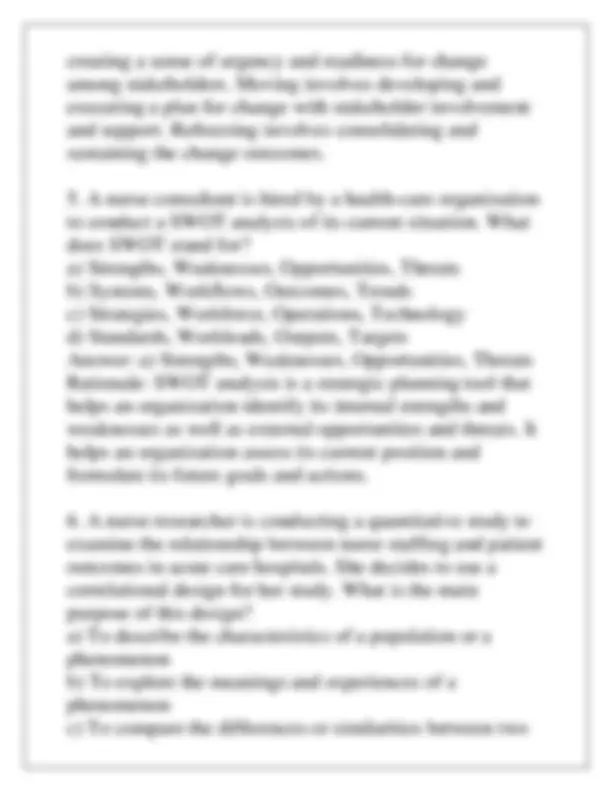
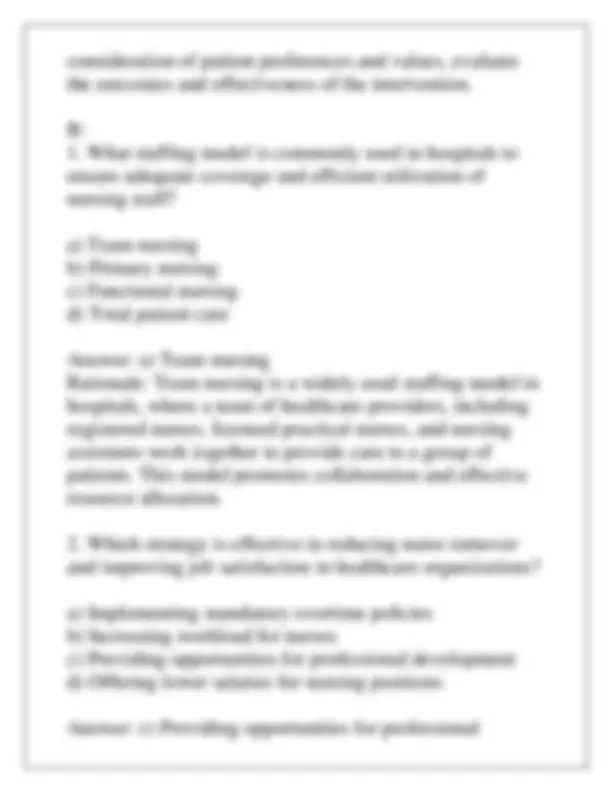
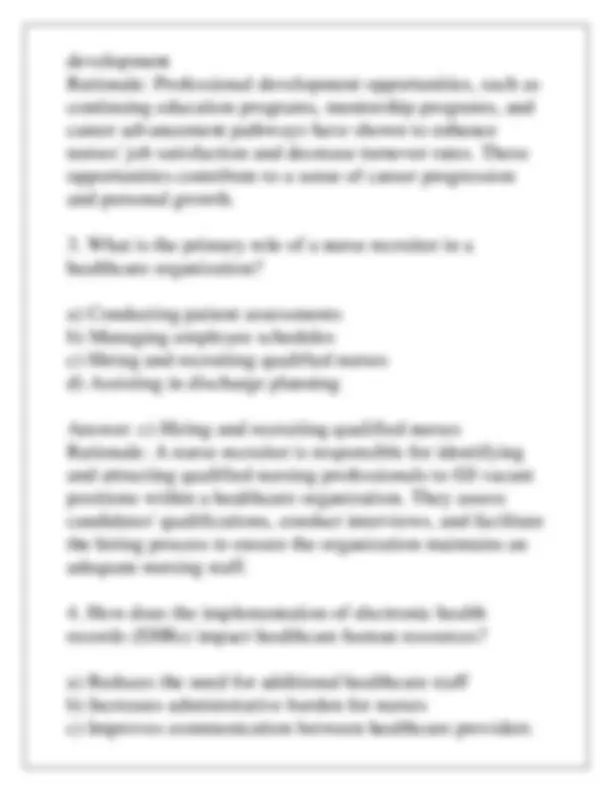
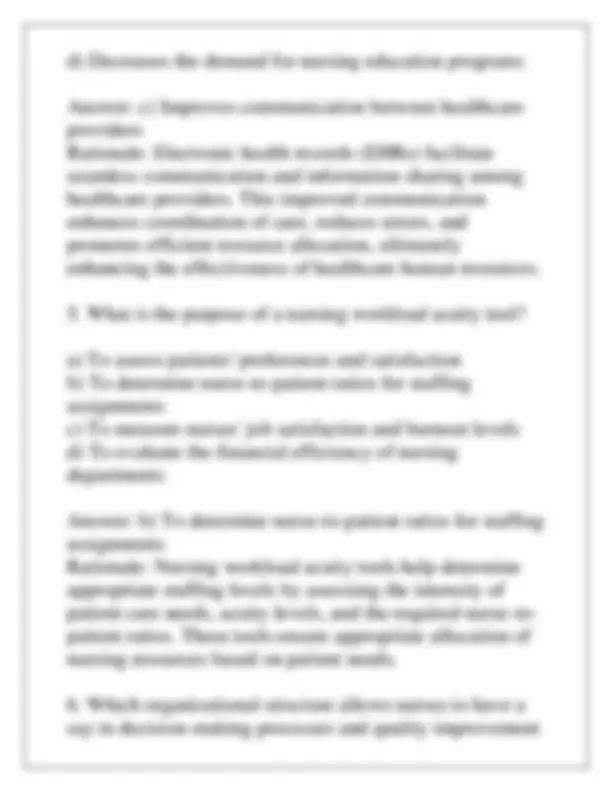
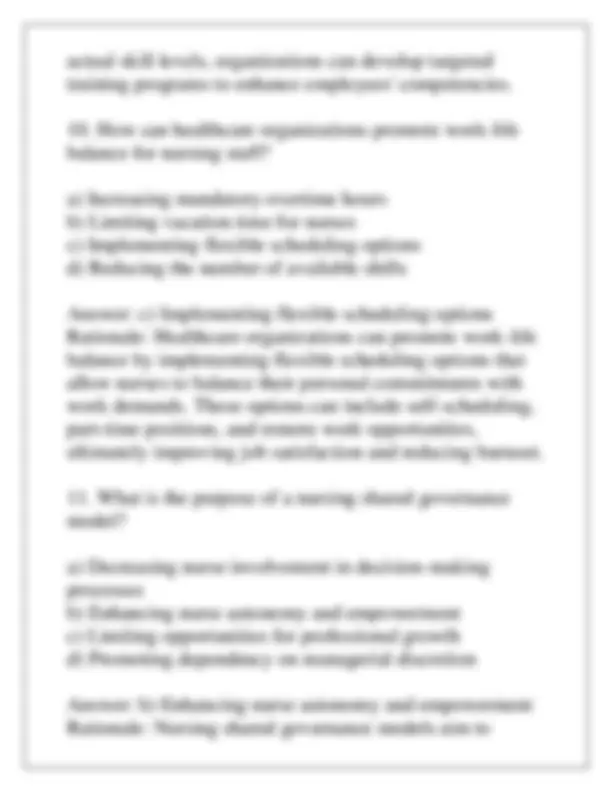

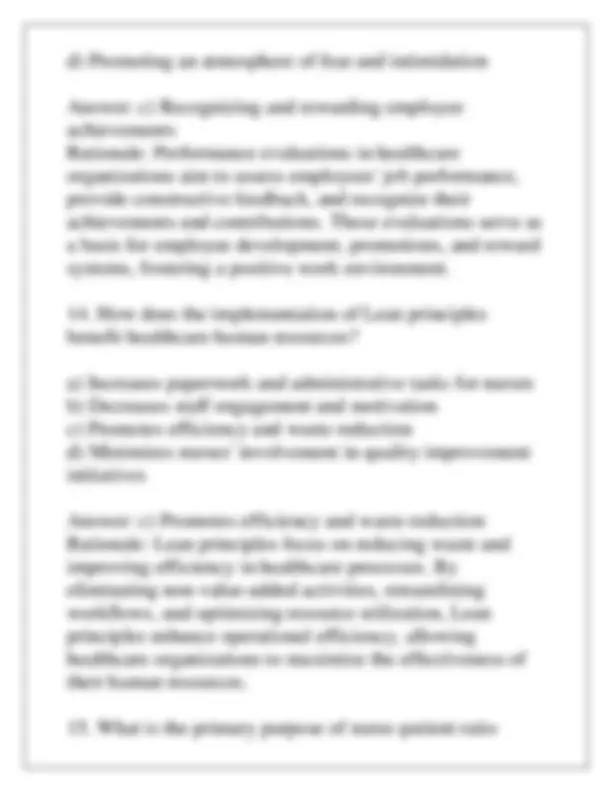
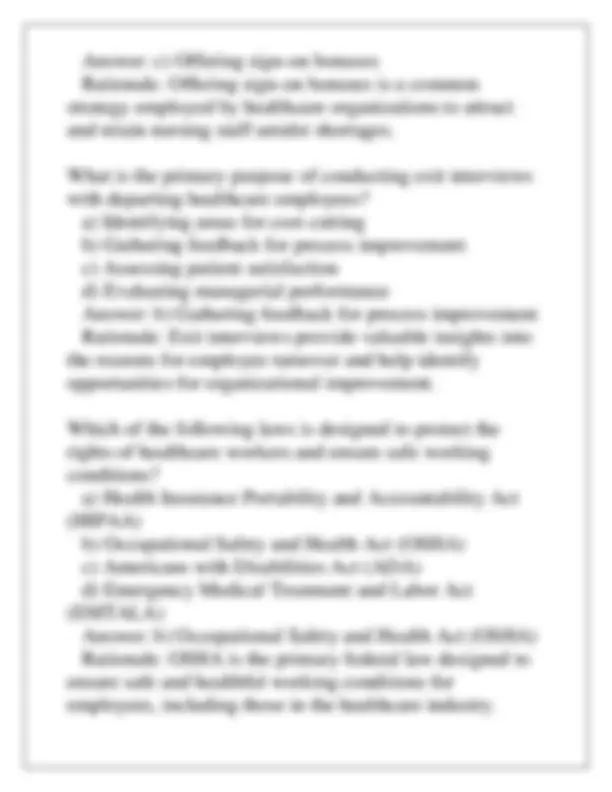
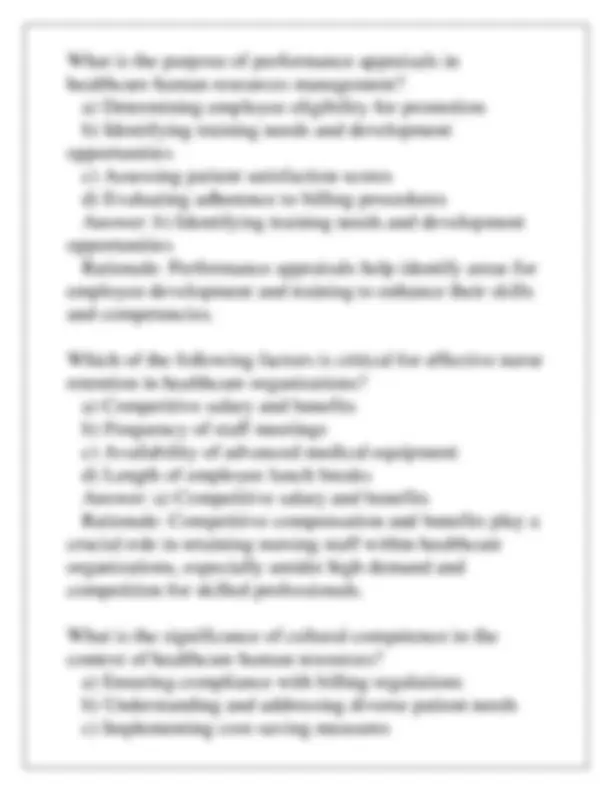
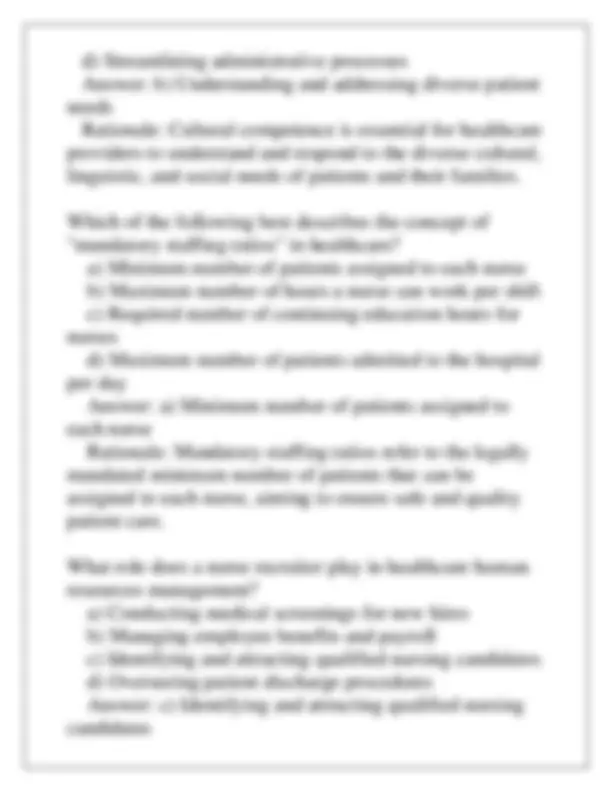
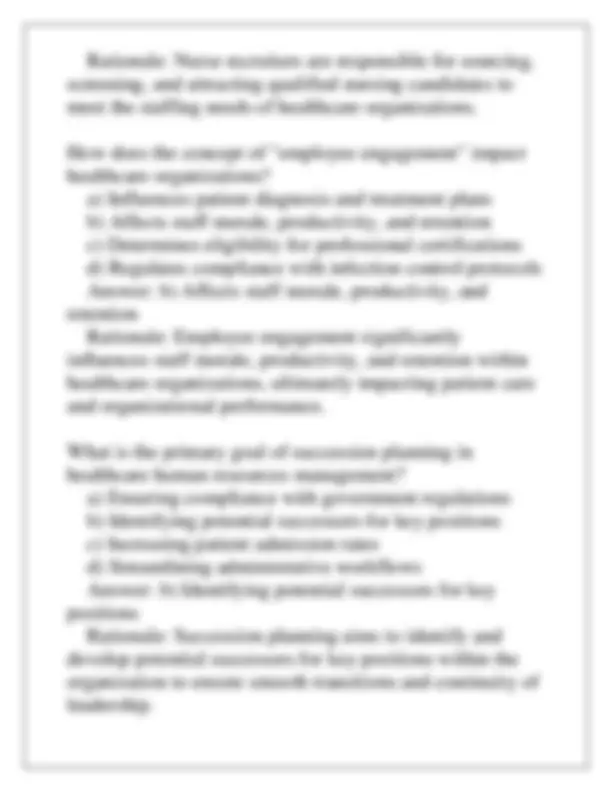
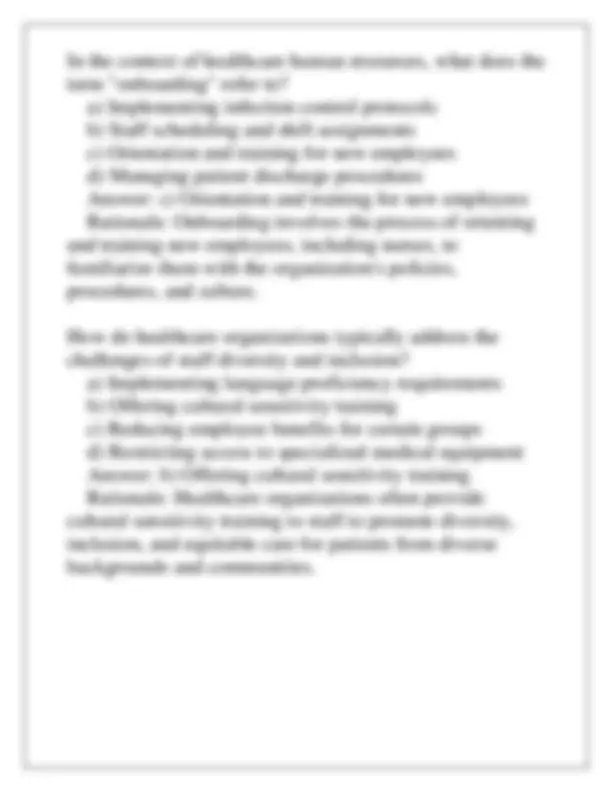


Study with the several resources on Docsity

Earn points by helping other students or get them with a premium plan


Prepare for your exams
Study with the several resources on Docsity

Earn points to download
Earn points by helping other students or get them with a premium plan
Community
Ask the community for help and clear up your study doubts
Discover the best universities in your country according to Docsity users
Free resources
Download our free guides on studying techniques, anxiety management strategies, and thesis advice from Docsity tutors
HSAD 321 HEALTH CARE HUMAN RESOURCES EXAM Q & A WITH RATIONALES 2024HSAD 321 HEALTH CARE HUMAN RESOURCES EXAM Q & A WITH RATIONALES 2024
Typology: Exams
1 / 22

This page cannot be seen from the preview
Don't miss anything!















b) The nurse leader, the nurse's peers, the nurse's mentors, and the nurse's interdisciplinary team members. c) The nurse leader, the nurse's supervisor, the nurse's preceptor, and the nurse's quality improvement committee members. d) The nurse leader, the nurse's colleagues, the nurse's educators, and the nurse's professional association representatives. Answer: b) The nurse leader, the nurse's peers, the nurse's mentors, and the nurse's interdisciplinary team members. Rationale: 360-degree feedback method is a performance appraisal technique that involves collecting feedback from multiple sources who have direct or indirect interactions with the employee. It provides a holistic and balanced view of the employee's strengths and areas for improvement. It also enhances communication, collaboration, and accountability among team members.
creating a sense of urgency and readiness for change among stakeholders. Moving involves developing and executing a plan for change with stakeholder involvement and support. Refreezing involves consolidating and sustaining the change outcomes.
Rationale: Cultural competence is the ability to provide effective and respectful care to patients from different cultural backgrounds. It involves being knowledgeable, sensitive, and respectful of the cultural diversity and uniqueness of patients. It also requires self-awareness, communication skills, and continuous learning.
consideration of patient preferences and values, evaluate the outcomes and effectiveness of the intervention. B:
d) Decreases the demand for nursing education programs Answer: c) Improves communication between healthcare providers Rationale: Electronic health records (EHRs) facilitate seamless communication and information sharing among healthcare providers. This improved communication enhances coordination of care, reduces errors, and promotes efficient resource allocation, ultimately enhancing the effectiveness of healthcare human resources.
initiatives? a) Hierarchical structure b) Flat organizational structure c) Functional structure d) Matrix structure Answer: b) Flat organizational structure Rationale: In a flat organizational structure, decision- making processes are decentralized, and individuals have increased autonomy and influence over their work. This structure encourages collaboration, teamwork, and active participation in quality improvement initiatives, allowing nurses to contribute to organizational decisions.
actual skill levels, organizations can develop targeted training programs to enhance employees' competencies.
involve frontline nurses in decision-making processes related to patient care, professional practice, and improvement initiatives. This empowers nurses to take ownership of their practice, enhances job satisfaction, and improves overall patient care outcomes.
legislation in healthcare? a) Limiting nurses' scope of practice b) Decreasing patient satisfaction scores c) Ensuring safe staffing levels for patient care d) Increasing healthcare costs Answer: c) Ensuring safe staffing levels for patient care Rationale: Nurse-patient ratio legislation aims to establish minimum staffing requirements to ensure safe care delivery and mitigate potential risks associated with understaffing. These regulations help ensure that nurses have the time and resources to provide adequate care, improving patient safety and outcomes. C: Which of the following best describes the role of a nurse manager in the context of human resources in healthcare? a) Overseeing patient care b) Managing staffing and scheduling c) Conducting medical procedures d) Administering medication Answer: b) Managing staffing and scheduling Rationale: Nurse managers are responsible for overseeing the staffing and scheduling of nurses within a healthcare facility, ensuring adequate coverage and efficient allocation of resources.
What is the primary purpose of workforce planning in healthcare organizations? a) Minimizing patient wait times b) Maximizing employee benefits c) Anticipating staffing needs d) Ensuring patient satisfaction Answer: c) Anticipating staffing needs Rationale: Workforce planning involves forecasting the future staffing requirements based on patient demand, seasonal variations, and other factors to ensure adequate coverage and optimal utilization of resources. In the context of healthcare human resources, what does the term "float pool" refer to? a) A group of nurses specialized in pediatric care b) Temporary staff hired for specific projects c) Nurses trained in emergency response d) A team focused on administrative tasks Answer: b) Temporary staff hired for specific projects Rationale: Float pools consist of temporary staff who can be assigned to different units or departments based on fluctuating patient volumes and staffing needs. Which of the following strategies is commonly used to address nursing shortages in healthcare organizations? a) Reducing patient admissions b) Implementing mandatory overtime c) Offering sign-on bonuses d) Decreasing nurse-patient ratios
What is the purpose of performance appraisals in healthcare human resources management? a) Determining employee eligibility for promotion b) Identifying training needs and development opportunities c) Assessing patient satisfaction scores d) Evaluating adherence to billing procedures Answer: b) Identifying training needs and development opportunities Rationale: Performance appraisals help identify areas for employee development and training to enhance their skills and competencies. Which of the following factors is critical for effective nurse retention in healthcare organizations? a) Competitive salary and benefits b) Frequency of staff meetings c) Availability of advanced medical equipment d) Length of employee lunch breaks Answer: a) Competitive salary and benefits Rationale: Competitive compensation and benefits play a crucial role in retaining nursing staff within healthcare organizations, especially amidst high demand and competition for skilled professionals. What is the significance of cultural competence in the context of healthcare human resources? a) Ensuring compliance with billing regulations b) Understanding and addressing diverse patient needs c) Implementing cost-saving measures
d) Streamlining administrative processes Answer: b) Understanding and addressing diverse patient needs Rationale: Cultural competence is essential for healthcare providers to understand and respond to the diverse cultural, linguistic, and social needs of patients and their families. Which of the following best describes the concept of "mandatory staffing ratios" in healthcare? a) Minimum number of patients assigned to each nurse b) Maximum number of hours a nurse can work per shift c) Required number of continuing education hours for nurses d) Maximum number of patients admitted to the hospital per day Answer: a) Minimum number of patients assigned to each nurse Rationale: Mandatory staffing ratios refer to the legally mandated minimum number of patients that can be assigned to each nurse, aiming to ensure safe and quality patient care. What role does a nurse recruiter play in healthcare human resources management? a) Conducting medical screenings for new hires b) Managing employee benefits and payroll c) Identifying and attracting qualified nursing candidates d) Overseeing patient discharge procedures Answer: c) Identifying and attracting qualified nursing candidates